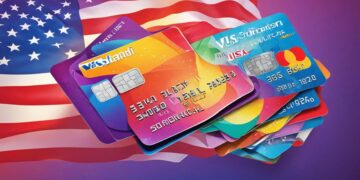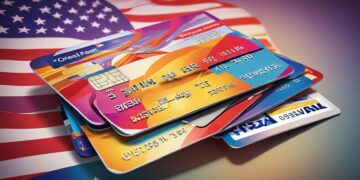How the minimum credit card payment works in the USA

The Intricacies of Minimum Credit Card Payments
The realm of credit cards is filled with opportunities and challenges, particularly when one grapples with the financial implications of minimum payments. Every month, cardholders face the decision of how much to pay toward their outstanding balance. This decision is crucial and often laden with confusion, making it essential to understand the underlying mechanics and consequences of minimum payment calculations.
How is the Minimum Payment Calculated?
Most credit cards set minimum payments as a percentage of the outstanding balance, typically ranging from 1% to 3%, plus any accrued interest and fees such as late payments. For example, if you have a balance of $1,000, and your card’s minimum payment rate is set at 2%, your minimum payment for that month could be around $20, plus any interest. This percentage approach may seem manageable in the short term, but it can create challenges over time.
The Long-term Implications of Paying Only the Minimum
Choosing to pay only the minimum amount can dramatically prolong the repayment period of your credit card debt. Consider this: if you have a balance of $5,000 on a card with an interest rate of 20%, making only the minimum payment could lead to a repayment term stretching over 20 years, costing you upwards of $4,000 in interest alone. This potential for extended debt can quickly spiral into a financial burden, reducing your overall financial health.
Factors Influencing Payment Amounts
Several variables influence the amount due each month. Promotional offers, which often feature a lower interest rate for a limited time, can create a false sense of security; however, if you carry a balance beyond the promotional period, the interest rate may spike significantly. Additionally, late fees can stack onto your balance, further complicating your payments. Lastly, changes in interest rates, which can occur due to shifts in the broader economy, also impact the total dues you’ll face monthly.
Empowering Financial Health Through Strategic Payments
Understanding these critical factors is essential for maintaining robust financial health. Credit cards, when managed effectively, can serve as valuable tools for building credit and managing expenses. However, to harness their full potential, one must pay more than just the minimum due each month. By increasing your payments, you can significantly reduce both the repayment period and total interest paid, ultimately leading to a more secure financial future.
In conclusion, navigating minimum payments requires a thorough understanding and proactive strategy. By familiarizing yourself with the calculation methods, recognizing the long-term impacts of minimum payment policies, and being aware of variable factors that influence your debt, you can make informed decisions that enhance your financial well-being. This knowledge is crucial for leveraging the benefits of credit cards while circumventing pitfalls that lead to spiraling debt and financial instability.
SEE ALSO: Click here to read another article
Understanding the Framework of Minimum Credit Card Payments
To fully grasp the implications of minimum payments on credit cards, it’s critical to delve into the various elements that influence their calculation and impact on borrowers. The world of credit cards can be deceptively complex, with terms and conditions often cloaked in financial jargon. For consumers in the USA, navigating this landscape requires not just awareness but also strategic planning. Let’s break down some key components, beginning with understanding how the minimum payment is derived.
Basic Elements of Minimum Payment Calculation
As previously mentioned, the minimum payment is generally a fraction of the outstanding balance, typically falling within the range of 1% to 3%. However, this formula can vary significantly between credit card issuers, often incorporating additional financial factors, such as:
- Interest Rates: Each month, your balance accrues interest depending on the Annual Percentage Rate (APR), which can range from as low as 10% to over 25%, depending on your creditworthiness and the card’s terms.
- Fees: Accumulated fees, such as late payment charges, can also be included in the minimum payment calculation, amplifying the amount due.
- Promotional Interest Rates: Introductory offers may provide lower rates temporarily but can lead to significant increases after the promotional phase ends.
For instance, consider a scenario: you have a balance of $3,000 with a card that specifies a 2% minimum payment rate. Your required payment would be around $60 (which does not include any additional interest or fees). Should interest accrue at a typical rate of 20%, your actual payment could be considerably higher by the time interest is applied, underscoring the importance of not only paying the minimum but strategizing payments effectively.
Understanding the Consequences of Minimum Payments
While paying the minimum may seem tempting, it carries significant consequences over time. For consumers who choose this route, the cost in terms of both time and money can be staggering. The following points illustrate the potential pitfalls of this strategy:
- Extended Repayment Terms: As previously indicated, paying only the minimum can lead to a repayment period that stretches over years, if not decades. This lengthy timeline can amplify interest costs dramatically.
- Credit Score Impact: Consistent minimum payments can signal financial distress to lenders, potentially affecting your credit score negatively. A lower score can hinder future borrowing opportunities.
- Emotional Stress: The burden of long-term debt can also take a toll on one’s mental well-being, creating perpetual anxiety about financial obligations.
Armed with this knowledge, consumers can better navigate their credit card usage. The key takeaway is that while minimum payments allow for short-term relief, they may lead to deeper financial challenges. Understanding the rules of engagement in credit card payments is crucial for anyone seeking to make informed choices about their finances.
SEE ALSO: Click here to read another article
The Dangers of Relying on Minimum Payments
While the allure of making just the minimum payment each month is undeniable, this financial strategy can lead to a precarious situation for many borrowers. In fact, studies indicate that a significant percentage of credit card holders (around 40% according to recent consumer finance reports) only pay the minimum due, often resulting in a cycle of debt that could last a lifetime.
Calculating the True Cost of Minimum Payments
Understanding the real cost of opting for minimum payments is crucial for any consumer navigating the credit card landscape. Take, for instance, a scenario where a person carries a balance of $5,000 at a 20% APR and is obligated to make a minimum payment of 2%. At first glance, the monthly minimum might appear manageable at $100. However, by solely adhering to this payment, the borrower could be trapped in a cycle where the remaining balance continues to accrue interest.
When you apply the credit card interest formula, the amount of interest added to the principal balance each month can drastically slow down the repayment process. Over time, even making these minimum payments can yield a total repayment cost exceeding the initial borrowed amount. For example, a borrower might end up paying over $10,000 to clear what began as $5,000 simply due to accumulating interest. This phenomenon not only prolongs the debt but also increases the stress that accompanies managing high-interest debt.
The Psychological Burden of Minimum Payments
Beyond the monetary implications, the psychological effects of relying on minimum payments cannot be understated. The constant presence of debt can lead to a persistent sense of financial instability, affecting not only an individual’s credit score but also their personal relationships and mental health. According to a study by the American Psychological Association, approximately 61% of Americans report financial stress, with credit card debt playing a significant role.
This stress often manifests in anxiety and depression, inhibiting individuals from living life to the fullest or making significant financial decisions. For many, the thought of being in debt can overshadow other areas of life, leading to poor financial planning and decision-making.
Alternatives to Minimum Payments
While the minimum payment option provides short-term relief, consumers should be aware of alternative strategies that will ultimately save them money and stress. One approach is to target higher-interest debts first – a method often referred to as the debt avalanche strategy. This entails making more than the minimum payment on higher-interest accounts while maintaining minimum payments on others, effectively reducing the total interest accumulated over time. Another method worth considering is the snowball method, which focuses on paying off the smallest debts first to achieve psychological wins that can motivate further progress.
Moreover, taking advantage of financial tools, such as budgeting apps or speaking to a financial advisor, could provide personalized strategies that cater to one’s unique situation. Joining financial literacy workshops or resources provided by community organizations may also empower individuals to better understand credit management, potentially transforming their relationship with credit cards.
Ultimately, while minimum payments may present a quick solution, they can lead to dire situations in the long run. Being informed about the costs, consequences, and alternative approaches is essential in making empowered financial decisions. With proactive planning, consumers can navigate their credit responsibly and avoid falling into a debt trap that hinders their financial growth.
SEE ALSO: Click here to read another article
Conclusion: Navigating the Minimum Payment Landscape
As we have explored, understanding how minimum credit card payments function in the USA is essential for making informed financial decisions. While the option to pay only the minimum can provide temporary relief, it often leads to a cycle of debt that can be overwhelming and costly. With around 40% of credit card holders opting for minimum payments, many unknowingly extend their debt duration and increase their overall costs significantly, sometimes paying over double the original amount borrowed.
The psychological effects cannot be ignored either; the burden of lingering debt contributes to financial stress experienced by a staggering 61% of Americans, impacting their mental health and overall quality of life. This reality reinforces the need for proactive debt management strategies, such as prioritizing high-interest debts or utilizing budgeting tools. Embracing a comprehensive approach to credit card repayment not only aids in financial recovery but can also lead to a more peaceful state of mind.
Ultimately, consumers are encouraged to seek alternatives to the minimum payment strategy. By educating themselves through resources such as financial literacy workshops and consulting with financial advisors, individuals can develop personalized plans that foster a healthier relationship with credit. Understanding the implications of minimum payments is a vital step toward financial empowerment and achieving long-term goals. The journey to financial literacy is ongoing, but taking control of credit card debt is a worthy investment in one’s financial future.






